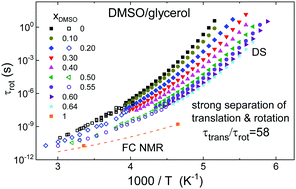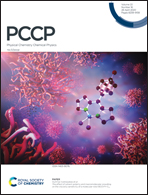Dielectric relaxation and proton field-cycling NMR relaxometry study of dimethyl sulfoxide/glycerol mixtures down to glass-forming temperatures
Abstract
Mixtures of glycerol and dimethyl sulfoxide (DMSO) are studied by dielectric spectroscopy (DS) and by 1H field-cycling (FC) NMR relaxometry in the entire concentration range and down to glass-forming temperatures (170–323 K). Molecular dynamics is accessed for 0 < xDMSO ≤ 0.64, at higher concentration phase separation occurs. The FC technique provides the frequency dependence of the spin–lattice relaxation rate which is transformed to the susceptibility representation and thus allows comparing NMR and DS results. The DS spectra virtually do not change with xDMSO and T, only the relaxation times become shorter. This is in contrast to the non-associated mixture toluene/quinaldine for which strong spectral changes occur. The FC relaxation spectra of glycerol in solution with DMSO or (deuterated) DMSO-d6 display a bimodal structure with a high-frequency part reflecting rotational and a low-frequency part reflecting translational dynamics. Regarding the rotational contribution in the glycerol/DMSO-d6 mixtures, no spectral change with xDMSO and T is observed. Yet, the non-deuterated mixture reveals a broader relaxation spectrum. Time constants τrot(T) probed by the two techniques complement each, a range 10−11 s < τ < 10 s is covered. The glass transition temperature Tg(xDMSO) is determined, yielding Tg = 149.5 ± 1 K of pure DMSO by extrapolation. Analysing the low-frequency FC NMR spectra allows to determine the diffusion coefficient Dtrans. Its logarithm shows a linear xDMSO-dependence as does lg τrot. The ratio Dtrans/Drot is independent of xDMSO and its low value indicates large separation of translation and rotation. The corresponding unphysically small hydrodynamic radius indicates strong failure of Stokes–Einstein–Debye relation. Such anomaly is taken as characteristics of a 3d hydrogen-bonded network. We conclude, although DMSO is an aprotic liquid the molecule is continuously incorporated in the hydrogen network of glycerol. Both molecules display common dynamics, i.e., no decoupling of the component dynamics is found in contrast to quinaldine/toluene with a similar Tg difference of its components.



 Please wait while we load your content...
Please wait while we load your content...